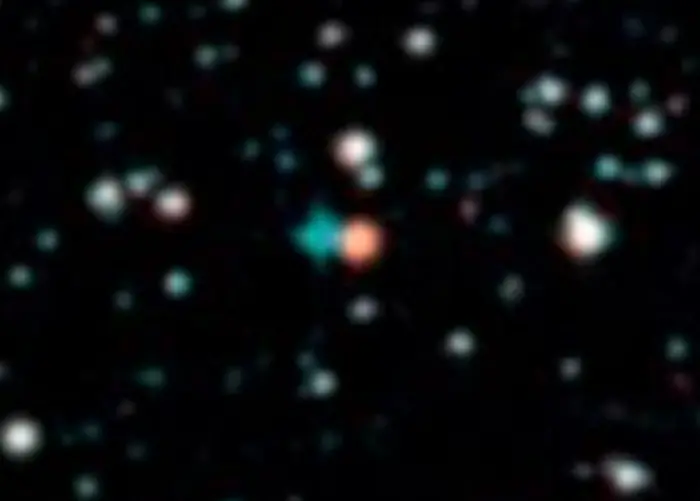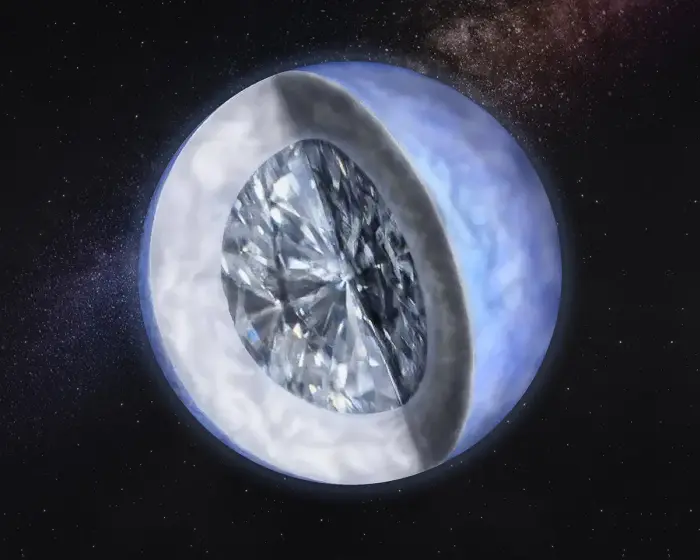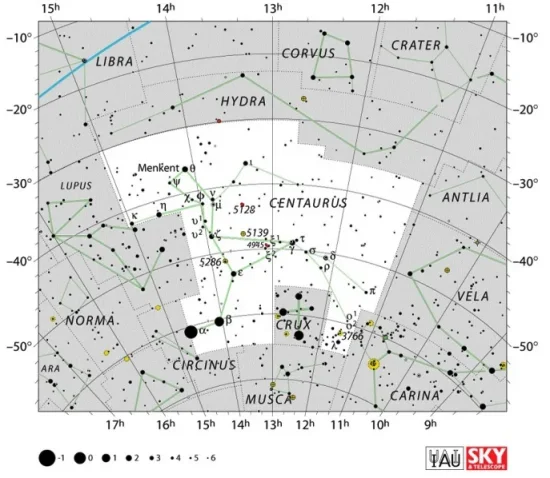V886 Centauri (BPM 37093) is a pulsating white dwarf located approximately 48.39 light-years away in the southern constellation Centaurus. With an apparent magnitude of 14, it is invisible to the unaided eye. The stellar remnant’s core is believed to be one of the largest diamonds in the local universe. The white dwarf has been nicknamed the Diamond Star or Lucy, after the Beatles’ song “Lucy in the Sky with Diamonds.”
Star type
BPM 37093 is a white dwarf, a remnant of a star that reached the end of its life and ejected its outer atmosphere into space. The white dwarf star has the stellar classification DAV4.4. It packs a mass of 1.10 solar masses into a radius of only 0.0057 stellar radii (4,000 kilometres or 2,500 miles). It has an effective temperature of around 11,730 K and shines with only 0.001 solar luminosities. The stellar remnant is composed mostly of carbon and oxygen.
White dwarfs are exceptionally dense objects. They are stellar core remnants of stars that are not massive enough to end their lives as supernovae. Instead, these stars expel their outer layers to form planetary nebulae and slowly fade away as white dwarfs for billions of years. Over 97% of stars in the Milky Way, including the Sun, will become white dwarfs at the end of their life cycles. The more massive stars that go out as supernovae become neutron stars or black holes, the only objects even denser than white dwarfs.
Composed mostly of electron-degenerate matter, white dwarfs have masses comparable to that of the Sun and radii similar to Earth’s. They have low luminosities because they only emit residual thermal energy. Unlike true stars, they do not fuse elements in their cores.

Lucy (BPM 37093), image: Wikisky
Facts
BPM 37093 has the variable star designation V886 Centauri. It is classified as a ZZ Ceti variable. ZZ Ceti variables of the spectral type DAV are pulsating white dwarfs with hydrogen-dominated atmospheres. They exhibit small variations in luminosity due to vibrations with periods of 30 seconds to 25 minutes. The rate of period change allows astronomers to directly measure the cooling timescale for these objects. As the white dwarfs cool, their pulsation periods become longer and the pulsational amplitudes become larger.
As a white dwarf cools, its material begins to crystallize, starting with the stellar core. BPM 37093 was the first example where the results of crystallization could be probed because, if the stellar remnant was crystallized, this would be evident in its pulsation spectrum.
BPM 37093 was the first white dwarf massive enough to theoretically crystallize while still on the ZZ Ceti instability strip, with an effective temperature of around 12,000 K. The higher mass would make the remnant subject to much higher pressures and densities in its core.
In 2004, observations with the Whole Earth Blazar Telescope (WEBT) led scientists to conclude that around 90% of the mass of V886 Centauri had already crystallized. A study led by A. Kanaan at the Universidade Federal de Santa Catarina (UFSC) in Brazil, Michael Montgomery of the University of Cambridge, and Travis Metcalfe at the Harvard-Smithsonian Center for Astrophysics used the Whole Earth Telescope to test the crystallization theory through asteroseismology. Asteroseismology allows astronomers to use a star’s frequency spectra to determine its composition. The telescope helped the researchers identify nine independent pulsation modes in V886 Cen.
A 2005 study by P. Brassard and G. Fontaine of the University of Montreal gave a fraction of 32% to 82% for the crystallized mass, depending on the chemical composition of the core. Even the smallest estimates would mean that V886 Centauri has more than 5 x 1029 kilograms of crystallized mass. The white dwarf was nicknamed Lucy because it is believed to be one of the largest diamonds in the solar neighbourhood. Like diamond, its core is composed of crystallized carbon.
In 2019, an asteroseismological analysis of V886 Centauri and a couple of other ultra-massive white dwarfs found a percentage of crystallized mass of 92% for Lucy and 97% for the white dwarf GD 518 in the constellation Draco. The study was led by Alejandro H. Córsico of the Universidad Nacional de La Plata in Argentina.

Lucy (BPM 37093), image credit: Harvard-Smithsonian Center for Astrophysics (PD)
Name
BD 37093 does not have an official name formally approved by the International Astronomical Union (IAU). The white dwarf is informally known as the Diamond Star or Lucy, after the Beatles’ 1967 hit “Lucy in the Sky with Diamonds.”
The stellar remnant is catalogued as BD 37093 in the Bruce Proper Motion Survey catalogue, WG 22 in the Wegner white dwarf catalogue, and Gliese 2095 (GJ 2095) in the Gliese Catalogue of Nearby Stars. It is also commonly referred to by its variable star designation V886 Centauri.
Location
The Diamond Star lies in the far southern sky, in the constellation of Centaurus. It appears near the second magnitude binary star Gamma Centauri (Muhlifain). Muhlifain can be found by extending a line through the axis of the Southern Cross, from Acrux through Gacrux.
At declination -50°, the white dwarf never rises for observers north of the latitude 40° N. With an apparent magnitude of 14, it is visible in medium-sized telescopes.

The location of BPM 37093 (V886 Centauri), image: Stellarium
Constellation
BPM 37093 is located in the southern constellation of Centaurus. The celestial Centaur is one of the Greek constellations, listed by Ptolemy of Alexandria in his Almagest in the 2nd century CE. It is one of the largest and brightest constellations in the sky. Stretching across 1,060 square degrees of the southern sky, it is the ninth largest of the 88 constellations.
Centaurus hosts two first magnitude stars – Rigil Kentaurus and Hadar (Alpha and Beta Centauri) – and four second magnitude stars. Alpha Centauri, the brightest star in Centaurus, is the third brightest star in the sky (after Sirius and Canopus) and the nearest star system to the Sun. The red dwarf Proxima Centauri, the nearest individual star to Earth, is part of the Alpha Centauri system. The hot blue giant Hadar, the second brightest star in Centaurus, is the 11th brightest star in the sky.

Centaurus constellation map by IAU and Sky&Telescope magazine
Other notable stars in the constellation include the K-type giant Menkent (Theta Centauri), the binary star Gamma Centauri, the blue giants Epsilon Centauri and Lambda Centauri, the hot blue variable star Eta Centauri, and the spectroscopic binary system Zeta Centauri.
Centaurus also hosts the yellow hypergiant HR 5171 (V766 Centauri), one of the largest stars known, and the rapidly oscillating Ap star HD 101065 (Przybylski’s Star), which has an unusual spectrum with over-abundances of rare-earth elements.
Centaurus features a number of bright deep sky objects. These include Omega Centauri, the largest known globular cluster in our galaxy, the open clusters NGC 5460 and NGC 3766, the active galaxy Centaurus A (NGC 5128), the barred spiral galaxy NGC 4945, the spiral galaxy NGC 4622 (the Backward Galaxy), the irregular galaxy NGC 5253, the emission nebula IC 2944 (the Lambda Centauri Nebula or Running Chicken Nebula), the protoplanetary Boomerang Nebula and the planetary nebula NGC 3918 (the Blue Planetary Nebula).
The best time of the year to observe the stars and deep sky objects in Centaurus is during the month of May, when the constellation appears higher above the horizon in the early evening. The entire constellation can be seen from locations south of the latitude 25° N.
The 10 brightest stars in Centaurus are Alpha Centauri (mag. -0.27), Hadar (Beta Cen, mag. 0.61), Menkent (Theta Cen, mag. 2.06), Gamma Centauri (mag. 2.17), Epsilon Centauri (mag. 2.30), Eta Centauri (mag. 2.35), Leepwal (Zeta Cen, mag. 2.55), Delta Centauri (mag. 2.57), Kulou (Iota Cen, mag. 2.73), and Lambda Centauri (mag. 3.13).
BPM 37093 – V886 Centauri
| Spectral class | DAV4.4 |
| Variable type | ZZ Ceti (DAV) |
| Apparent magnitude | 14.0 |
| Distance | 48.39 ± 0.01 light-years (14.836 ± 0.004 parsecs) |
| Parallax | 67.4058 ± 0.0186 mas |
| Radial velocity | 73.0 ± 1.3 km/s |
| Proper motion | RA: -557.111 ± 0.014 mas/yr |
| Dec.: -74.036 ± 0.013 mas/yr | |
| Mass | 1.10 M☉ |
| Luminosity | 0.001 L☉ |
| Radius | 0.0057 R☉ |
| Temperature | 11,730 ± 350 K |
| Surface gravity | 8.81 ± 0.05 cgs |
| Constellation | Centaurus |
| Right ascension | 12h 38m 49.7811220835s |
| Declination | −49° 48′ 00.219515411″ |
| Names and designations | BPM 37093, GJ 2095, V886 Cen, WG 22, GCRV 27461, GSC 08240-02502, LFT 931, LHS 2594, LTT 4816, NLTT 31372, PLX 2912.01, PM 12360-4932, LAWD 41, L 327-186, TIC 160522890, 2MASS J12384981-4948001, WD 1236-495, WD 1236-49, WISEA J123849.17-494800.9, uvby98 600104816, Gaia DR2 6127333286605955072, Gaia DR3 6127333286605955072 |